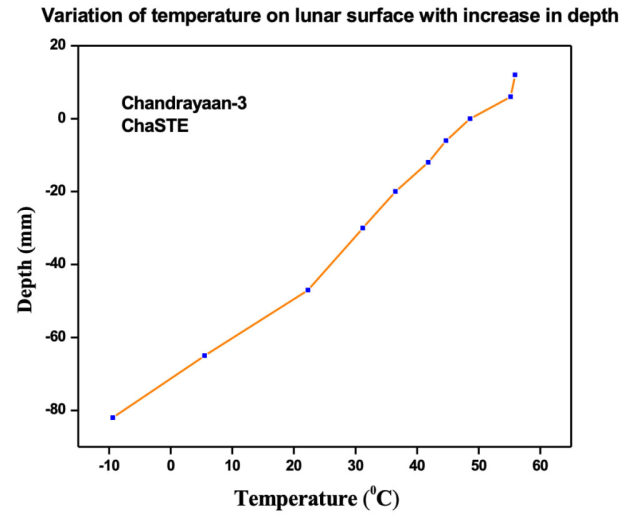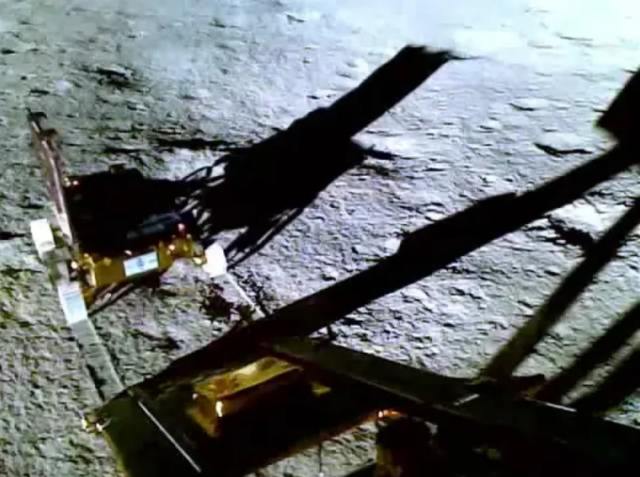The Vikram lander measured the temperature in the circumpolar region of Selenium and found out that the soil at the surface there is significantly hotter than scientists previously thought.
The Indian Space Agency (ISRO) has received the first ever scientific data from the southern polar region of the Moon. The Vikram descent module learned how the temperature changes on the lunar surface, near it and at depth. The device measured the fluctuations of the regolith from the surface to a depth of eight centimeters.
"Among the scientific instruments of the descent module there is a tool (ChaSTE. — Ed.), which allows measuring the temperature of the near-surface lunar layer at the landing site. This device is equipped with ten thermal sensors and is a probe that dives into the regolith to a depth of ten centimeters, and then measures the thermal conductivity of the soil," ISRO said in a press release.
Indian scientists have published a graph of the temperature profile of the regolith layer, which was compiled by the ChaSTE device for the first lunar day of Vikram's operation. The recorded temperature was surprisingly higher than expected.
"We assumed that the temperature near the surface at the landing site is 20-30 degrees Celsius, but in fact it is much higher — 70 degrees," ISRO explained.
 |
| Temperature profile of the lunar regolith layer. |
| Source: ISRO |
During the lunar day and night, the surface of the Moon undergoes a high temperature drop. Closer to night, it can drop below 100 degrees, and by noon it will rise to plus 100. Scientists believe that a loose layer of lunar regolith with a thickness of 5-20 meters can be a kind of thermal insulator, which is probably why there is a significant temperature difference between the surface and depth.
Data on how the temperature of the lunar soil in the circumpolar regions changes with depth is important because, according to modern concepts, below a certain point in the lunar soil, the temperature can be above zero, and the pressure can be close to the earth's. If this is the case, then the water ice in such layers of the lunar soil can melt, forming an environment with liquid water. That, in contact with a number of rocks, is able to give an environment suitable for the nutrition and reproduction of some microorganisms. But although temperature changes with depth may indicate the potential subsurface habitability of the Moon, there is no more or less accurate data on such temperature changes today.
As can be seen from the very first scientific data of Chandrayan-3, reality in this sense may differ significantly from the simulation results. It is possible that the zones of periodic "thawing" of the lunar permafrost are much closer to the lunar surface and, therefore, more accessible for future research.
In any case, further research will help not only to explain the temperature differences in the southern polar region of the Moon, but also to learn more about the composition and structure of the regolith in this region.
Chandrayan-3 is an Indian space mission to explore the South Pole of the Earth's natural satellite, which includes a flight station, the Vikram lander and the Pragyan lunar rover.
Vikram landed on the lunar surface on August 23, in the southern circumpolar region, where human vehicles had never landed before. Indian scientists named the landing site Shiva-Shakti — in their opinion, the soil in this area is rich in water ice.
The Chandrayan-3 mission completed two of the three tasks set: the soft landing of the lander with a six-wheeled lunar rover on board, and the successful descent of the lunar rover from the module. The third — scientific experiments at the landing site — are now in the process of implementation.
According to the plan, the Vikram lander and the Pragyan lunar rover will work on the Moon for 14 Earth days.

